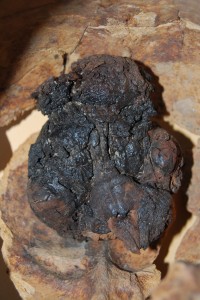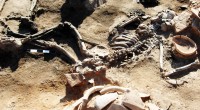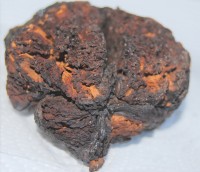 Archaeologists excavating the Bronze Age mound of Seyitömer Höyük near the Western Anatolian city Kütahya in Turkey discovered a skull with a preserved brain still inside in 2010 and have now published the results of extensive scientific analysis of the brain and its archaeological context in the Journal of Comparative Human Biology. The brain was found in a middle Bronze Age layer, dating it to around 4,000 years ago. Optically stimulated luminescence testing on the samples dated them at 1900–2000 B.C., confirming the stratigraphic results.
Archaeologists excavating the Bronze Age mound of Seyitömer Höyük near the Western Anatolian city Kütahya in Turkey discovered a skull with a preserved brain still inside in 2010 and have now published the results of extensive scientific analysis of the brain and its archaeological context in the Journal of Comparative Human Biology. The brain was found in a middle Bronze Age layer, dating it to around 4,000 years ago. Optically stimulated luminescence testing on the samples dated them at 1900–2000 B.C., confirming the stratigraphic results.
The layer showed signs of a devastating fire. Charred wooden debris was found along with partially burned human skeletons. Four of those skeletons contained the remains of brain tissue inside skulls cracked by the ancient conflagration. Tissue from two of the partial brains was sampled for histological analysis and the most intact, best preserved specimen was removed for study and for a future museum display.
 Unlike the glistening, rubbery 2500-year-old Heslington brain (still one of my favorite all time pictures), this one is blackened and hard. Its grooves and basal ganglia are still distinct giving it the look of a sponge but the texture of petrified wood. Researchers used computerized tomography to look inside the brain and found surviving diencephalic (the posterior of the forebrain), metencephalic (the cerebellum and pons) and occipital (back of the head) tissue.
Unlike the glistening, rubbery 2500-year-old Heslington brain (still one of my favorite all time pictures), this one is blackened and hard. Its grooves and basal ganglia are still distinct giving it the look of a sponge but the texture of petrified wood. Researchers used computerized tomography to look inside the brain and found surviving diencephalic (the posterior of the forebrain), metencephalic (the cerebellum and pons) and occipital (back of the head) tissue.
This is an exceptional instance of soft tissue survival, particularly notable because the brain is one of the first organs to liquefy after death because of its high fat content. The fire that devastated the tumulus 4,000 years ago played a major role in this preservational fluke. A fault line crosses the layer in which the brains were found and the area is seismically active. Professor Meriç Altinoz from Haliç University in Istanbul posits that an earthquake leveled the settlement after which fire burned through the debris and human remains. The brains boiled in their own fluids until there was no fluid left. The fire consumed all the oxygen in the rubble layer, which left behind brain tissue dried to a crisp and in a low oxygen environment, a recipe for long-term survival of organic material.
 The particular chemical composition of the soil was also a significant factor. From analysis of the brain matter, bones, teeth, soil surrounding the skeletons, researchers found high levels of boron, potassium, magnesium, aluminum. The Kütahya area had the largest boron mines in the country, a resource that made it a center for glazed tile production under the Ottoman Empire. Boron naturally repels insects and bacteria which is why the Egyptians used boron in the mummification process. The naturally high levels of boron in the soil may have aided in the preservation of the carbonized brains in the 4,000 years since the fire, converting the tissue into a ceramic of sorts, a bioporcelain, as the researchers term it. Potassium, magnesium, aluminum create the highly alkaline environment necessary for the formation of adipocere, aka corpse wax, which preserved the shape of the brain tissues.
The particular chemical composition of the soil was also a significant factor. From analysis of the brain matter, bones, teeth, soil surrounding the skeletons, researchers found high levels of boron, potassium, magnesium, aluminum. The Kütahya area had the largest boron mines in the country, a resource that made it a center for glazed tile production under the Ottoman Empire. Boron naturally repels insects and bacteria which is why the Egyptians used boron in the mummification process. The naturally high levels of boron in the soil may have aided in the preservation of the carbonized brains in the 4,000 years since the fire, converting the tissue into a ceramic of sorts, a bioporcelain, as the researchers term it. Potassium, magnesium, aluminum create the highly alkaline environment necessary for the formation of adipocere, aka corpse wax, which preserved the shape of the brain tissues.
“The level of preservation in combination with the age is remarkable,” says Frank Rühli at the University of Zurich, Switzerland, who has examined medieval brain tissue. Rühli says that most archaeologists don’t bother looking for the remains of brain tissue because they assume it is seldom preserved. “If you publish cases like this, people will be more and more aware that they could find original brain tissue too.”
In cases where the brain is as well preserved as this, Rühli says it might even be possible to look for pathological conditions such as tumours and haemorrhaging, and maybe even signs of degenerative disease. “If we want to learn more about the history of neurological disorders, we need to have tissue like this.”
Your posts often make me very, vary happy, but this one has me issuing morbid-fangirl “squee”s. “Bioporcelain” – fabulous! [Loved the link to the older post, too; I think that was from before I stumbled across your blog, so I’d missed it.] Now, where did I put my Qwiggle brain-mold?
There is little that pleases me more than the discovery of ancient organs that have found a way to survive the ages. I join you, therefore, in your morbid fangirling squees. We’re coming up on brain-mold season. You should make one inspired by the Heslington brain and take a picture so I can post it. 😀
real magic on the brain which archaeologists discovered them. This contribution is enormous in many fields such as chemistry, medicine, history …The article is very interesting.I like this article :yes: